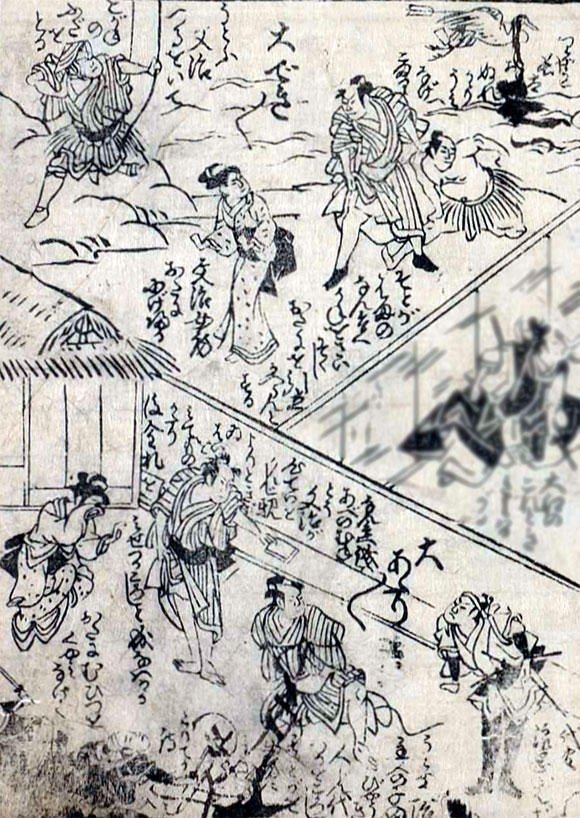| BUNJI SUMIKA |
| Play title | ďshű Adachi-ga-Hara |
|||||||||||||||
| Authors | Chikamatsu Hanji Takeda Izumi Kitamado Goichi Takemoto Saburobŕ II |
|||||||||||||||
| History |
Chikamatsu Hanji's play in five acts "ďshű Adachi-ga-Hara" was originally written for the puppets theater in 1762. It was adapted for Kabuki in the 2nd lunar month of 1763 and staged at the Moritaza [casting|illustrations]. The historical background of this play is the zenkunen war, which opposed the Abe clan, ruler of the northern provinces of Japan (ďshű), to the Minamoto clan. The latter clan, led by Minamoto no Yoriyoshi and his son Minamoto no Yoshiie, defeated the former clan, led by Abe no Yoritoki and his two sons, Abe no Sadat˘ and Abe no Munet˘. After the war, the two sons became fugitives and the play is about their actions and their last murder attempts against their victor. The playwrights also integrated within this drama two famous ďshű legends, the ogress of Adachi-ga-Hara and the ut˘ bird. In modern times, "Bunji Sumika" was revived only a few times. Here is the list of all performances in ˘shibai from the end of WWII to 2001:
|
|||||||||||||||
| Structure |
"Tsuru Goroshi" ("The Killing of a Crane") and "Bunji Sumika" ("At Bunji's home") are the two main scenes of the 2nd act of "ďshű Adachi-ga-Hara". They are rarely staged these days. They are occasionally revived as the first act of a t˘shi ky˘gen production of "ďshű Adachi-ga-Hara". |
|||||||||||||||
| Key words |
Abe Munet˘ Abe Sadat˘ Abe-shi Abe Yoritoki Genji Gidayű Ky˘gen Jidaimono Minamoto Yoriyoshi Minamoto Yoshiie ďshű Soto-ga-Hama Torite Tsuru Tsuru Goroshi Ut˘ Zenkunen |
|||||||||||||||
| Summary |
Tsuru Goroshi While his wife is diving to gather shellfish, Ch˘ta, a diver, tries to seduce Otani, who is the wife of the hunter Ut˘ Bunji, on the Soto-ga-Hama Beach in ďshű, but dives into the sea as Takaemon, the local magistrate, comes with the village headman. Calling villagers in the neighborhood, the local magistrate conveys to them the government order not to kill cranes to whose legs gold tags are attached. Otani goes to the doctor's to buy medicine for her son Kiyod˘. When she comes back to the beach she meets her husband Bunji, who tells her that he will be able to get enough money to buy the very expensive medicine needed to cure his son's disease. Soto-ga-Hama Nambei, a local gambler and money-lender, who has lent money to Bunji, comes to demand the repayment to Bunji. The hunter promises to pay back in two or three days and goes away. Nambei catches hold of Otani, saying that he will take her as a hostage, but is compelled to release her as Ch˘ta comes out of the sea to interrupt him. Later that night, Bunji kills a crane with an arrow, takes the gold tags and quickly runs away. The village official Sh˘emon visits the house of Ut˘ Bunji. As Bunji is absent, Sh˘emon shows his wife Otani the government order not to kill cranes to whose legs gold tags are attached. Sh˘emon reads the order for Otani, who is illiterate. After Sh˘emon has gone, Soto-ga-Hama Nambei comes with a brothel proprietor to buy Otani as a courtesan. Otani does not agree though she is badly in need of money to save her son's life. Bunji returns and hands to Nambei a gold tag as a partial repayment of his debt. The brothel proprietor goes away but Nambei stays in the house to receive the remaining part of the debt. Bunji writes a letter and asks Otani to take it to the military governor's office, saying that the letter is to inform the local authorities that Soto-ga-Hama Nambei has killed a sacred crane. In fact, the letter says that Bunji himself has killed the crane but Otani, being illiterate, cannot read it. Bunji prays at the household Buddhist altar, saying that he is offering his last prayer to the spirit of Abe no Yoritoki and Bunji's father Yasuhide, who served the daimy˘ Abe no Yoritoki when he ruled ďshű. Hearing this, Nambei reveals to Bunji that he is in fact Abe no Munet˘, one of the two sons of Abe no Yoritoki, and that together with his elder brother, Sadat˘, he is planning to avenge the death of their father, who lost the Zenkunen war, defeated by the Genji leaders Minamoto no Yoriyoshi and his Minamoto no Yoshiie (commonly called Hachiman Tar˘). Otani gladly comes back, carrying a huge amount of money given as a reward for the tip-off about the crane killer. She is surprised, however, to know that the killer mentioned in Bunji's letter was not Nambei but Bunji himself. When Otani starts crying, her son Kiyod˘ rises from his bed, clinging to a folding screen, and falls with the screen, dead. When a group of torite, led by the military governor Shinobu Gunji, comes to arrest Bunji, Nambei offers himself as the criminal, showing the gold tag as the evidence of his offence. Nambei tells Bunji that he has taken his place because he believes by doing so he will be able to confront Minamoto no Yoshiie in Ky˘to. Bunji tries to kill himself, holding himself responsible for the death of Kiyod˘, who in fact is not his son but Sadat˘'s son. Nambei dissuades him, saying that Bunji's help is indispensable to the Abe family's fight for revenge. |
 |
|
The "Tsuru Goroshi" (top) and "Bunji Sumika" (bottom) scenes of the drama "ďshű Adachi-ga-Hara", which was staged in 1828 at the Wakadayű no Shibai (ďsaka) |
|
|
| Contact | Main | Top | Updates | Actors | Plays | Playwrights | Programs | Links | FAQ | Glossary | Chronology | Illustrations | Prints | Characters | Derivatives | Theaters | Coming soon | News |